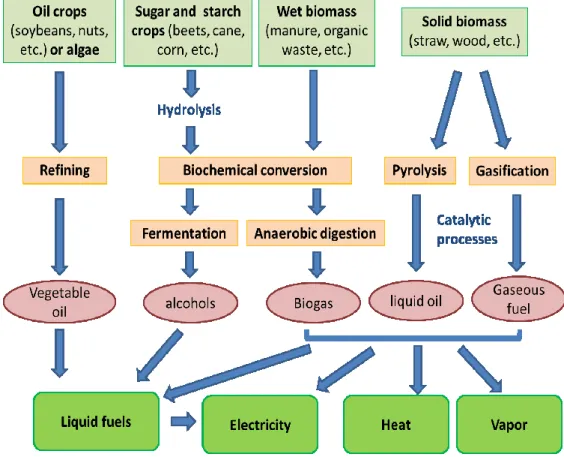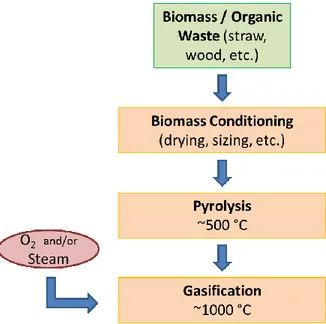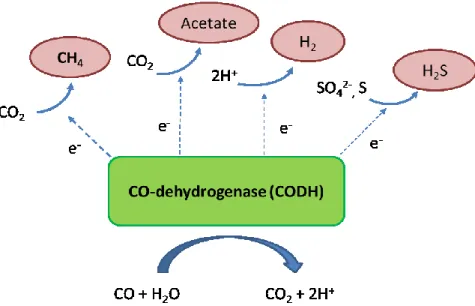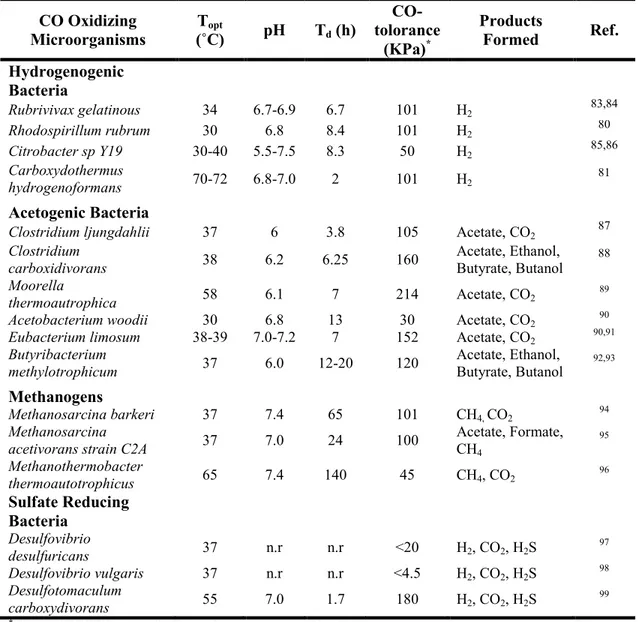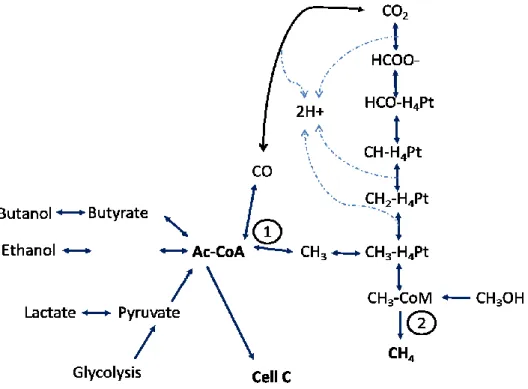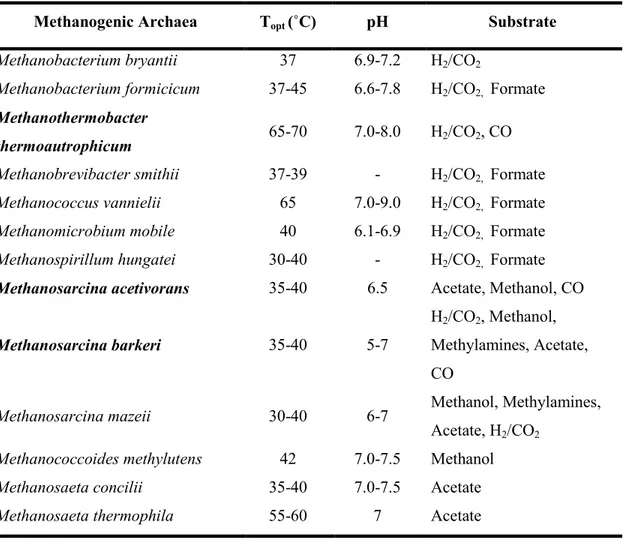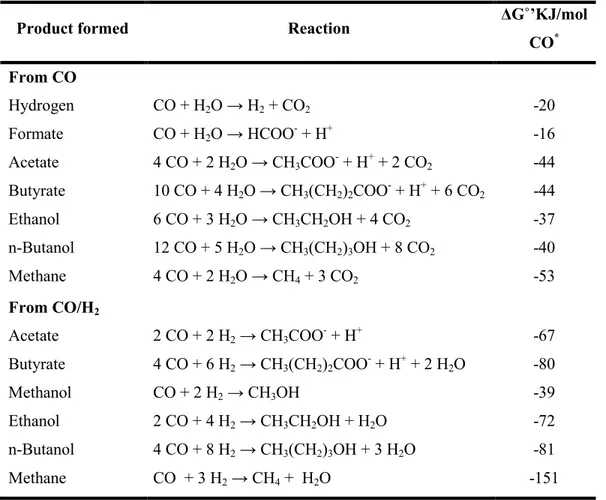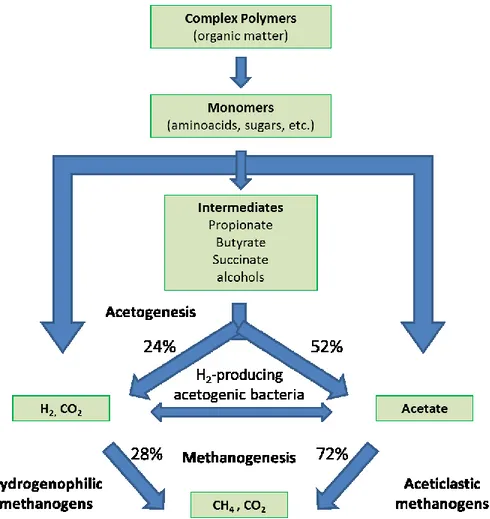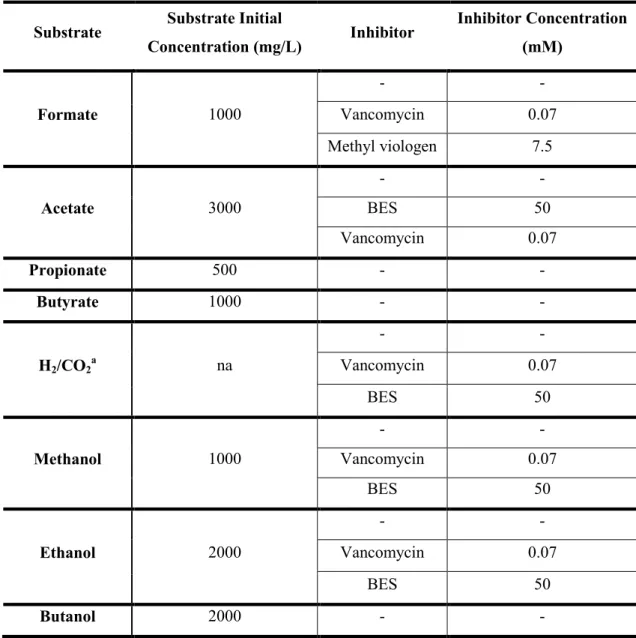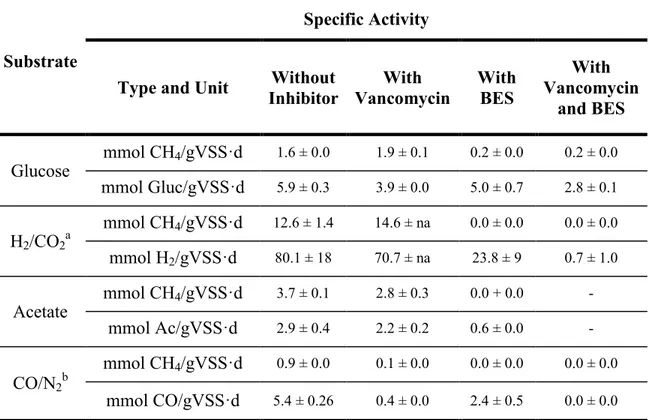Biomethanation of syngas: identification of metabolic
pathways from CO in a natural anaerobic
consortium
par
Silvia Sancho Navarro
Département de Microbiologie et Immunologie Faculté de Médecine
Mémoire présenté à la Faculté des études supérieures en vue de l’obtention du grade de Maîtrise
en Microbiologie et Immunologie
Juin 2012
Université de Montréal Faculté des études supérieures
Ce mémoire intitulé :
Biomethanation of syngas: identification of metabolic
pathways from CO in a natural anaerobic consortium
présenté par : Silvia Sancho Navarro
a été évalué par un jury composé des personnes suivantes :
Dr Hallenbeck, président-rapporteur Dr Serge Guiot, directeur de recherche Dre Viviane Yargeau, Membre du jury
Au cours des dernières décennies, l’intérêt pour la gazéification de biomasses a considérablement augmenté, notamment en raison de la grande efficacité de recouvrement énergétique de ce procédé par rapport aux autres procédés de génération de bioénergies. Les composants majoritaires du gaz de synthèse, le monoxyde de carbone (CO) et l’hydrogène (H2) peuvent entre autres servir de
substrats à divers microorganismes qui peuvent produire une variété de molécules chimiques d’intérêts, ou encore produire des biocarburants, particulièrement le méthane. Il est donc important d'étudier les consortiums méthanogènes naturels qui, en syntrophie, serait en mesure de convertir le gaz de synthèse en carburants utiles.
Cette étude évalue principalement le potentiel de méthanisation du CO par un consortium microbien issu d’un réacteur de type UASB, ainsi que les voies métaboliques impliquées dans cette conversion en conditions mésophiles. Des tests d’activité ont donc été réalisés avec la boue anaérobie du réacteur sous différentes pressions partielles de CO variant de 0.1 à 1,65 atm (0.09 à 1.31 mmol CO/L), en présence ou absence de certains inhibiteurs métaboliques spécifiques. Dès le départ, la boue non acclimatée au CO présente une activité carboxidotrophique relativement intéressante et permet une croissance sur le CO. Les tests effectués avec de l’acide 2-bromoethanesulfonique (BES) ou avec de la vancomycine démontrent que le CO est majoritairement consommé par les bactéries acétogènes avant d’être converti en méthane par les méthanogènes acétotrophes. De plus, un plus grand potentiel de méthanisation a pu être atteint sous une atmosphère constituée uniquement de CO en acclimatant auparavant la boue. Cette adaptation est caractérisée par un changement dans la population microbienne désormais dominée par les méthanogènes hydrogénotrophes. Ceci suggère un potentiel de production à large échelle de biométhane à partir du gaz de synthèse avec l’aide de biofilms anaérobies.
Mots clés : Monoxyde de carbone, gaz de synthèse, conversion anaérobie, biométhanisation, méthanogènes hydrogénotrophes, méthanogènes acétotrophes, boue granulaire, UASB.
Syngas produced through the thermal gasification of biomass for energy recovery has received increased attention in the past decades due to its higher efficiency compared to other bioenergy processes. The gas components of syngas, CO and H2, can serve as substrates for the conversion of desirable chemicals and
fuels, namely methane, by a wide range of microorganisms. Meanwhile, anaerobic wastewater-treating sludges have been reported as good sources of carboxidotrophic microorganisms which can be exploited for methane production. Thus it is important to investigate existing methanogenic consortiums which, in syntrophy, are able to convert syngas into useful fuels.
This study is mainly focused on the assessment of the carboxidotrophic methanogenic potential present in a natural consortium of microorganisms from a UASB reactor and the identification of CO conversion routes to methane under mesophilic temperatures. To achieve this, a series of kinetic-activity tests with the anaerobic sludge were performed under CO partial pressures varying from 0.1 to 1.65 atm (0.09-1.31 mmol/L) in both the presence and absence of specific metabolic inhibitors. The non-adapted sludge presented an interesting carboxidotrophic activity potential for growing conditions on CO alone. Inhibition experiments with 2-bromoethanesulfonic acid (BES) and vancomycin showed that CO was converted mainly to acetate by acetogenic bacteria, which was further transformed to methane by acetoclastic methanogens. Moreover, it was possible to achieve higher methanogenic potential under 100% CO by acclimation of the sludge. This adaptation led to a shift in the microbial population predominated by hydrogenophilic methanogens. This suggests a possible enrichment potential with anaerobic biofilms for large scale methane production from CO-rich syngas, and further advances the knowledge base for anaerobic reactor development.
Key words: Carbon monoxide, synthesis gas, anaerobic conversion, biomethanation, hydrogenophilic methanogens, acetoclastic methanogens, granular UASB sludge.
RÉSUMÉ ... iii
ABSTRACT ... v
TABLE OF CONTENTS ... vii
LIST OF TABLES ... xi
LIST OF FIGURES ... xiii
LIST OF ABBREVIATIONS ... xv
ACKNOWLEDGEMENTS AND DEDICATIONS ... xix
CHAPTER 1 ... 1
Introduction ... 1
1.1 Biomass as an Energy Source ... 3
1.1.1 Potential Methane Production from Organic Wastes Overview ... 6
1.2. Gasification of Biomass ... 8
1.2.1 Synthesis Gas ... 10
1.3. CO-Rich Syngas Conversion to Methane ... 11
1.3.1. Parameters that can Affect the CO Bioconversion to Methane ... 14
1.3.1.1. Effect of pH ... 15
1.3.1.2. Effect of Temperature ... 17
1.3.1.3. Effect of Media Composition ... 18
1.3.1.4. Effect of Substrate Partial Pressure ... 19
1.3.1.5. Mass Transfer Effect ... 21
1.4. CO-Consuming Anaerobic Microorganisms ... 24
1.4.1. Hydrogenogens ... 26
1.4.2. Acetogenic Carboxidotrophs ... 28
1.4.3. Carboxidotrophic Methanogens ... 30
1.5. Syntrophic Methane Production from CO in a Natural Anaerobic
Consortium. ... 35
1.6. Advantages and Disadvantages of CO Bioconversion to Methane by Natural Anaerobic Biofilms from a Wastewater-Treatment UASB reactor. ... 38
CHAPTER 2 ... 43
Objectives and hypothesis... 43
CHAPTER 3 ... 45
Preliminary Work: Effectiveness of the Selected Inhibitors and Characterization of the Methanogenic Potential Pathways of the Anaerobic Sludge ... 45
Use of Specific Inhibitors for Characterization of Methanogenic Potential Pathways from CO in a Natural Consortium from an Anaerobic Digestion Reactor ... 47
CHAPTER 4 ... 63
Article ... 63
Biomethanation of CO: Identification and Classification of Metabolic Pathways in a Natural Consortium from an Anaerobic Digestion Reactor ... 65
ABSTRACT ... 65
1. INTRODUCTION ... 67
2. MATERIAL AND METHODS ... 70
3. RESULTS ... 74 4. DISCUSSION ... 83 5. CONCLUSION ... 87 6. Acknowledgements ... 88 7. Supplementary information ... 89 CHAPTER 5 ... 91 Discussion ... 91 Perspective ... 96
REFERENCES ... 97
SUPPLEMENTARY WORK ... i
APPENDIX I ... iii
Pressure effect ... iii
APPENDIX II ... ix
Granules vs. Suspended Biomass ... ix
APPENDIX III ... xv
INTRODUCTION
Table I. Characteristics of some anaerobic carboxydotrophic microorganisms. ... 27 Table II. General characteristics of some methanogenic archaea. ... 31 Table III. Reported reactions from CO and CO/H2.. ... 36
PRELIMINARY WORK
Table IV. Substrate and specific inhibitors concentrations applied in the bottles. .... 50 Table V. Fermentative and methanogenic specific activities of the anaerobic sludge
under different substrate conditions and effecting presence of vancomycin (0.07 mM), and BES (50 mM) ... 52 Table VI. Anaerobic digestion sludge methanogenic activity from different
substrates in the absence and presence of different specific inhibitors. ... Error! Bookmark not defined.57
ARTICLE
Table VII. Carboxidotrophic and methanogenic activities of anaerobic sludge and product formed under different initial CO concentrations in absence of inhibitors at 35˚C. ... 76 Table VIII. Carboxidotrophic and methanogenic activities of anaerobic sludge and
product yields under different CO concentrations in the presence of BES (50 mM), and Vancomycin (0.07 mM) ... 78 Table IX. Comparison of the sludge CO conversion rate and methanogenic potential
under 100% CO in the gas phase over time. ... 81 Table X. Evolution of the eubacterial and archaeal population in the sludge over
APPENDIX I
Table XI. Pressure effects on carboxidotrophic and methanogenic activities at low and high dissolved CO concentrations in absence and presence of inhibitors at 35˚C. ... v
APPENDIX III
Table XII. PCR primers used to determine the presence of vancomycin resistant genes. ... xix Table XIII. Evolution of the eubacterial population in the sludge over the time, in
the presence and absence of vancomycin under an atmosphere of 100% CO as determined by DGGE experiments. ... xxii Table XIV. Evolution of the archaeal population in the sludge over the time, in the
presence and absence of vancomycin under an atmosphere of 100% CO as determined by DGGE experiments. ... xxxxiii
INTRODUCTION
Figure 1. Bioenergy conversion processes from biomass. ... 4 Figure 2. Main Steps in a Biomass Gasification System. ... 9 Figure 3. Anaerobic respiration coupled to CO oxidation. ... 25 Figure 4. Carbon flow in the metabolisms that employ the acetyl-CoA pathway .... 28 Figure 5. Anaerobic microbial conversion of biomass to methane ... 40 PRELIMINARY WORK
Figure 6. Comparison of the CH4 and CO time course under different vancomycin
concentrations, and vancomycin (0.07 mM) re-addition every 10 days. ... 54
ARTICLE
Figure 7. CO consumption, and CH4 and H2 production rates without inhibitors, in
presence of BES, and vancomycin, at 0.2 atm of CO and 1.1 atm of CO in the headspace... 75 Figure 8. Blocking of potential pathways involved in CO conversion to methane by
inhibitors. ... 77 Figure 9. Suggested pathways for conversion of CO into CH4 present in the
anaerobic consortium.. ... 86
APPENDIX II
Figure 10. Comparison of the carboxidotrophic specific activity and methanogenic yield under different PCO for granules and suspended biomass. In the absence
and presence of inhibitors, BES and vancomycin. ... xi Figure 11. Carboxidotrophic and methanogenic specific activity ratio of granules
APPENDIX III
Figure 12. DGGE analysis of the microbial population diversity in the anaerobic digestion sludge over the 2 month incubation period... xx Figure 13. PCR experiments for the detection of vancomycin resistance encoding
ACS: Acetyl-coenzyme A synthase AD: Anaerobic digestion
atm: Atmosphere
ATP: Adenosine triphosphate BES: 2-bromoethanesulfonic acid
BLAST: Basic Local Alignment Search Tool
bp: Base pair (s)
˚ C: Degree Celsius
CH4: Methane
CH3COOH: Acetate
CH3OH: Methanol
CO: Carbon monoxide
CO2: Carbon dioxide
CoA: Coenzyme A
COD: Chemical oxygen demand (g/L) CODH: Carbon monoxide dehydrogenase
CoM: Coenzyme M
16S rDNA: Genomic deoxyribonucleic acid
d: Day
DGGE: Denaturing Gradient Gel Electrophoresis DNA: Deoxyribonucleic acid
Ech-hydrogenase: Escherichia coli hydrogenase EDTA: Ethylenedinitrolotetraacetic acid FID: Flame ionization detector
g: Gram
GJ: Gigajoule
H: Henry’s constant (L atm mol-1)
h : Hour H2: Hydrogen H2O: Water H2S : Hydrogen sulphide Kb: Kilobase KJ: Kilojoule KPa : Kilopascal L: Litre LPS: Lipopolysaccharides L: Microlitre µM: Micromolar mg: Milligram min: Minute mL: Millilitre mM: Millimolar mm: Millimetre mmol: Millimole ms: Millisecond
MSW: Municipal solid waste
Mtr : Enzyme N-methyl-H4SPT:CoM methyltransferase
N2: Nitrogen
Na2EDTA: Disodium ethylenediamine tetraacetate
ng: Nanogram
Ni: Niquel
PCO: CO partial pressure
PCR: Polymerase chain reaction RDP: Ribosomal Database Project RNG : Renewable natural gas ΔG˚’: Standard Gibbs free energy
SD: Standard Deviation
SDS : Sodium dodecyl sulfate
sec: Second
SO42-: Sulfate
TAE : Tris-acetate-EDTA
TCD: Thermal conductivity detector
Td : Doubling time
TEN: Tris-EDTA-NaCl
TJ: Terajoule
Topt : Temperature optima
t/year: Tonne per year
UASB: upflow anaerobic sludge blanket reactor
V: Voltage
VFA: Volatile Fatty Acids (mg/L) VS: Volatile solids (g/L)
VSS: Volatile suspended solids (g/L) WGS : Water gas shift reaction wt/vol: Weight per volume
Throughout my work at the Biotechnological Research Institute-National Research Council of Canada, Montreal, I have been accompanied by many people both professionally and personally who I would like to thank in writing how much I appreciate their constant encouragement, support and assistance that has been a cornerstone for the realization of my master project.
In the first place my deepest gratitude goes to my supervisor Ruxandra Cimpoia, for her guidance throughout the study. I would like to thank her for her advice and instructive suggestions that help me to develop the ability to quickly evaluate, and achieve independent objectives through my project.
I would like to express a sincere gratitude to my research director Dr. Serge Guiot, chief of the Environmental Bioengineering group of the Biotechnology Research Institute, for the opportunity he gave me to be part of his team, and introduce me to the anaerobic digestion world.
Many thanks to my program sponsor Luke Masson, for the great advice, guidance, and encouragement throughout my master program.
I would like to thank every member of the environmental Bioengineering team who I had the privilege to meet during the 3 year program and for their kindly help on experimental manipulation and good suggestions on my project. Particularly, I would especially like to thank Guillaume Bruant and Marie J. Levesque for their guidance and help provided conducting the biomolecular analyses.
I will also like to thank George Szatmari, whose moral support and timely administrative interventions made it possible for me to complete my graduate program and who encouraged me to become part of the Université de Montreal team even though I didn’t know any French upon my arrival to Montreal.
I am grateful for the financial support provided from National Research Council of Canada (NRCC) which gave me the chance to pursue my graduate program, and the “Ministerio de Ciencia e Innovacion” from Spain that provided me the fabulous loan that paid for my studies and expenses in Canada.
Special thanks is given to the following wonderful people who made my master program a lot easier and kept my feet on the ground when it was necessary. Punita Mehta, Aureline Prudhomme, Rekia Hamani, Lia Rocha, Charlene Little, Laura Gil, Tuana Mesquita, Nina Gorgani, Paola Escobar and Valentina Muñoz for all the fun, support, friendship, and above all, for making of this a great, living experience. Muchisimas gracias chicas.
Finally, I want to dedicate this thesis to the people that made it worthwhile, my mom Rosa Mª Navarro Mestre, my dad Luis J Sancho Sanz, my sister and her boyfriend Cristina Sancho Navarro and Javi Bou Mateu for their wise tips and lovely thoughts provided to me every day even while we are at thousands of km of distance. To all my friends for their understanding, and the happiness they provided to me. My parents in law Jacinthe Arpin and Ian Perowne, and brother in law Eric Perowne for their encouragement along my studies, and for showing and sharing with me the customs and many adventures in this lovely country, previously unknown to me.
And last but not least, I want to dedicate this thesis to my amorin Gregory Perowne for all his unconditional love and positivity through the 3 years program; who showed me that everything is possible in life, and made me realize how many hidden skills we have. Of course I thank him for the painful time he spent correcting my English grammar for the present study, and to support me and my mood swings through my redaction period. But the most important I thank him for laughing with me in the good moments, and making me laugh in the hard ones. Te quiero.
Introduction
Energy needs are increasing worldwide due to humanity’s population growth and the accelerated development of industry leading to today’s goal of replacing current non-renewable and scarce fossil fuel sources. A recent study estimated fossil fuel depletion at the current consumption rate for oil, coal and gas at approximately 35, 107 and 37 years, respectively1. Therefore it is necessary to find new alternatives for the production of sustainable energy to mitigate these energy needs. Nowadays, the use of renewable energy sources like biomass or solid waste has become one of the most promising sources for energy production, which at the same time supports the reduction of harmful fossil fuel gas emissions that largely contribute to global warming2–5.
There are several well established processes for the conversion of different types of biomass into renewable energy sources like biodiesel or synthetic natural gas. However, some of the most established techniques for cleaner fuel production such as anaerobic digestion, direct fermentation of easily degradable substrates, still have issues regarding their efficiency since a large proportion of organic material cannot be degraded by the microorganisms6,7. One solution to overcome the limitation of poor biomass conversion with this kind of fermentation could be to gasify the biomass and further use the converted gas components (called synthetic gas or syngas) as a building block for the production of desired renewable fuels such as methane7,8.
A recent report from the Canadian Gas Association together with the Alberta Research Council stated that the use of gasification of biomass versus anaerobic digestion has the potential to produce most of the renewable natural gas in Canada in the near future9. However, despite the advantages of using syngas fermentation for
clean fuel production, much more research in this field needs to be done. Deeper understanding of the microbiological aspects implicated in syngas fermentation will allow further improvement of the bioreactor setup, and consequently the advancement of syngas derived fuels at large scale.
One approach to lower the cost of this process is the use of already existing anaerobic consortiums, which in syntrophy will be able to convert syngas components (i.e. CO, H2) into useful fuels such as methane. Anaerobic
wastewater-treating sludge has been reported as a good source of carboxidotrophic microorganisms which can be exploited for methane production at large scale10,11.
This study was therefore planned to assess the carboxidotrophic methanogenic potential present in a natural anaerobic consortium of microorganisms from an upflow anaerobic sludge blanket reactor (UASB). A second objective was to better understand the metabolic routes implicated in methane production from carbon monoxide (CO), the main component of syngas, under mesophilic temperatures.
1.1 Biomass as an Energy Source
Renewable energy sources like biomass or solid waste have become a promising sources for energy production4. This new trend of using organic waste for green energy production could be beneficial in two ways: it supports the reduction of fossil fuel gas emissions, such as the release of carbon dioxide into the atmosphere that largely contributes to the global warming, and at the same time contributes to the reduction of municipal and industrial solid wastes, whose accumulation has increased worldwide12.
In a recent study in 2006, Levin et al. speculated that the residual biomass generated annually in Canada, approximately 1.45 x 108 t with an estimated energy value of 2.28 x 109 GJ, could account for about 22% of Canada’s current annual energy use13.
The most commonly used bioenergy conversion processes can be summarized as follows: the refining of oil from crops (i.e. sunflowers oil) or algae, anaerobic fermentation of sugar and starch feedstock (i.e. beet, cereals), anaerobic fermentation of wet biomass (i.e. organic waste, manure), and the pyrolysis, combustion or gasification of solid biomass9,14,15. The use of different technologies for biomass conversion depends on the type of material present in the biomass and the desired final use of the product (Figure 1).
These energy production techniques can be divided in three groups clearly defined depending on the mechanism used to transform the biomass into useful fuels. In biochemical conversion processes, the organic material is degraded directly by microorganisms for the production of energy sources. Examples of this group are the anaerobic digestion of organic biomass, which leads to the production of methane, and the carbohydrate fermentation, which leads to the production of bioethanol15. The second group of techniques for biomass conversion is the use of chemicals extracted from biomass for the production of improved fuels. An example of this group is the vegetable or algal oil refining process for liquid fuels production, such as
biodiesel14. The last group is the use of thermochemical processes for energy production, where biomass is converted into chemicals and heat at high temperatures and pressure, eventually followed by catalytic conversion into more valuable products. Gasification of biomass and Fischer-Tropsch reactions are good examples of this group8,10.
Figure 1. Bioenergy conversion processes from biomass16.
Anaerobic digestion (AD) is one of the most cost-effective and widely studied processes for the production of biomass derived fuels and chemicals such as methane17. However, the main drawback of this method is the small percentage of organic material that can be degraded by microorganisms due to biomass’ polymeric nature. Thus, it is necessary to perform a chemical hydrolysis of the poorly
degradable materials, increasing the cost of the process. An interesting alternative to overcome this issue is the gasification of biomass into syngas7. The main components of syngas, carbon monoxide (CO) and hydrogen (H2), can then be used as a feedstock
for a wide variety of microorganisms for fuel production, namely methane, to produce renewable natural gas (RNG)18–20.
Another possible alternative is the direct use of hydrogen for energy production since it would provide higher energetic advantages than methane and would increase the overall efficiency of the process. However, storage options for hydrogen are limited due to high costs, security challenges (more flammable and buoyant than methane), missing infrastructure and short lifetimes of fuel cells21–23. In contrast, renewable natural gas (RNG) can easily be stored and distributed due to its higher energy density and boiling point. For example, liquid methane has three times the energy density of hydrogen and requires less storage space. Additionally, opposite to hydrogen, methane is compatible with the current natural gas network and gas devices (i.e. gas pipelines, engines, natural gas powered vehicles, etc.)21.
Natural Gas Vehicles for America (NGVA) states that waste biomass could supply enough natural gas for about 11 million natural gas vehicles, which represents approximately 5 percent of the America’s vehicles24.
Moreover, in a recent study Alberta Innovates-Technology Future formerly Alberta Research Council claimed that methane production from Canadian waste in the next 5 to 10 years through anaerobic digestion processes will be the main source of RNG, with gasification contributing afterwards9. This conclusion was based on current technology, the level of industry acceptance, and the need for further technology development in the gasification industry9.
In fact, the gasification of industrial and municipal solid waste is believed to be among the most efficient technologies for energy recovery nowadays, and at the same time contributes to the reduction of the continuously increasing municipal solid waste (MSW)12.
1.1.1 Potential Methane Production from Organic Wastes
Overview
Thanks to the continual technological advances in renewable energy production, most of today’s waste has the potential to be converted into energy sources such as methane. The more organic materials are present in the waste, the more efficient the methane production process becomes. This type of biomass is mostly generated by the agricultural, forestry and municipal sector9,25.
The knowledge of waste composition and its production rate in contemporary society can serve as a tool for the estimation of the methane production potential that can be achieved with different bioenergy processes. This will help improve economical waste management planning in order to reach higher energy yields.
Agricultural wastes mostly come from crop residues (i.e. wheat. corn, soybeans, etc.) and animal manures (i.e. cattle, chicken). Forestry residues include mainly wood and waste produced from wood processes. Besides, waste from the municipal sector is composed of solid waste from residential and industrial facilities (MSW), landfills, municipal wastewater (WW), and municipal biosolids collected from wastewater treatments25,26.
In a recent report concerning methane’s production potential from Canadian waste sources, prepared by Alberta Innovates Inc. in collaboration with the Canadian Gas Association, a potential production of 24.9 Mt/year of renewable natural gas (RNG) was estimated from the total Canadian waste produced by the agricultural, forestry and municipal sectors9. The authors calculated that the forestry sector has the potential of producing 12.9 Mt/year of RNG, in addition to 8.8 Mt/year from agricultural waste and 3.2 Mt/year from municipal waste. Moreover, statistical comparisons between anaerobic digestion (AD) and gasification processes for total methane production potential from Canadian wastes showed that the use of biomass gasification has the potential to produce 84% (21 Mt/year) of the total Canadian RNG output, whereas it was estimated that only 16% (3.9 Mt/year) of the total RNG can be
produced from anaerobic digestion processes since AD processes are limited by the polymeric nature of poorly degradable materials present in potential biomass sources. However, the latter is the most commonly used method for bioenergy production due to its technological availability and lower cost9.
Moreover, the authors stated that the potential RNG estimated per year which corresponds to an energy value of 1.4 x 103 TJ, which could theoretically replace a significant amount of the current residential and commercial natural gas use9.
Furthermore, many studies have documented that the production and capture of methane from organic waste contributes to the reduction of greenhouse gas emissions13,14,27.
1.2. Gasification of Biomass
Gasification basically consists of the partial oxidation of organic material such as fossil fuels or biomass at temperatures between 500 and 1500˚C, without total combustion, in the presence of oxygen or steam as an oxidizer10. This process takes place in a gasifier, and the result is a mixture of combustible and non-combustible gases called synthesis gas. The syngas, following clean-up to remove impurities, can be directly used in gas turbines and internal combustion engines as well as fuel cells for generating heat and/or electricity10,28. Moreover, syngas can be used as a raw material for the production of synthetic and/or natural chemicals, as well as liquid and gaseous fuels such as methane which can be employed to replace natural gas derived from fossil fuel sources8,9.
Gasification is a very efficient process in terms of energy production compared to other thermal bioenergy conversion techniques such as the combustion of biomass. This is mainly because compared to direct combustion, where part of the energy is lost in the combustion process, with syngas most of the energy contained in the organic material can be extracted with the further use of microorganisms9,29.
Moreover, since any kind of material can undergo gasification, it is very useful when the organic matter is difficult or slow for microorganisms to degrade, such as relatively dry materials like straw or wood, or even when the organic matter is entirely non-biodegradable (i.e. plastic, rubber, etc.)10.
There are 3 main steps in synthesis gas production. First, the organic material needs to be conditioned before its use depending on the feedstock (drying, sized, etc.). Then, the material is pyrolized at temperatures between 300-500˚C to produce gases, tars, bio-oils, and solid char, and is lastly gasified, where the products are transformed into syngas in the presence of an oxidizer8,29 (Figure 2).
Figure 2. Main Steps in a Biomass Gasification System8.
There are two kinds of gasification depending on the type of oxidant employed: direct gasification, where the organic material is partially oxidized using air and/or oxygen, and indirect gasification, which utilizes steam as the oxidizing agent. The latter being the more efficient as it is thermodynamically more favourable8,30. The use of the different methods depends mainly on the organic source
used. For biomass gasification it is preferable to use air or oxygen as the oxidant, while indirect gasification is employed in the case of fossil fuels6.
1.2.1 Synthesis Gas
Synthesis gas is derived from the gasification of a wide variety of organic sources such as coal, petroleum coke, oil, catalytic reforming of natural gas31,32, and biomass including industrial and municipal solid wastes32,33.
Syngas is mainly composed of carbon monoxide (CO), hydrogen (H2), and
carbon dioxide (CO2), but also has minor amounts of other gases such as methane
(CH4), nitrogen (N2), and hydrogen sulphide (H2S). However, the gas composition of
synthesis gas varies depending on the type of organic material used for gasification and its properties (moisture, ash, dust, tar content, etc.)34, the gasification process
employed (type of oxidant), the type of gasifier (fixed bed, fluidized bed, etc.), and the reactor’s operational conditions (temperature, pressure, etc.)8,35.
Thus the composition of synthesis gas can be modified through the optimization of the gasification process. It has been reported that gasification at high temperatures between 1500-1800˚C for coal, and 1100˚C for biomass produces higher CO and hydrogen concentrations within the syngas, which in turn are the main precursors for the production of different fuels such as methane8,36.
Moreover, it has been proven that using pure oxygen as the oxidant agent can reduce N2 content in the syngas to increase the concentration of targeted syngas
1.3. CO-Rich Syngas Conversion to Methane
Synthesis gas obtained from gasification of fossil fuels, biomass, and/or solid wastes can be further converted to methane, as previously commented, through the application of chemical or biochemical processes.
The main components of syngas, CO and hydrogen, can be used for methane production via the methanation catalytic reaction according to the following equation:
CO + 3H2 → CH4 + H2O (Eq. 1)
This reaction is carried out at elevated temperatures and pressure in the presence of chemical catalysts, making it a faster method than with bioconversion processes32,38. In order to increase the H
2/CO ratio necessary for the completion of the
reaction, this process produces pure hydrogen through the catalytic water gas sift reaction (WGS), converting the CO present in the syngas into hydrogen and CO2,
(Eq. 2):
CO + H2O → H2 + CO2 (Eq. 2)
Catalytic reactions can also be applied to the production of a wide variety of fuels and chemicals such as ethanol, methanol, acetate, etc. (Fischer-Tropsch sysnthesis 39.
The main drawback with the use of chemical catalytic processes is the high sensitivity to the impurities present in synthesis gas. Hence, the process can be easily inactivated due to the presence of tar, oil and other gas contaminants such as sulfur8. In order to avoid catalyst poisoning these impurities need to be totally removed from
the syngas, or at a minimum reduced to a certain tolerated level40. However, the purification step to eliminate all of the impurities prior to methane production requires the use of advanced cleaning systems, making this method complex and costly. A solution to solve all these drawbacks with chemical catalysts processes is the use of microorganisms as a biocatalysts for syngas conversion to methane7,10,32.
Anaerobic microorganisms can be exploited for the production of a variety of interesting metabolites from the syngas components. These products include gaseous fuels such as methane and H2, organic acids (i.e. acetate, propionate, formate,
butyrate, and lactate), as well as many alcohols such as methanol, ethanol and butanol8,41.
Despite the slower syngas methane conversion rate achieved with the use of microorganisms as a catalyst, it still presents several advantages over the catalytic process. The higher specificity of the enzymes implicated in the biochemical reaction improves the product yield, which simplifies recovery, and also reduces the formation of toxic by-products8,42. Furthermore, the microorganisms act as a cheap catalytic source for methane production and possess higher tolerance to sulfur and other impurities present in syngas when compared to chemical catalysts43,44. Hence cleansing synthesis gas in order to remove impurities prior to its utilization can be avoided, decreasing the overall cost of the process.
Moreover, most of the microorganisms employed as catalysts are able to grow well on CO alone, permitting a low H2/CO ratio in the syngas 45,46.Lastly, the use of
methanogenic microorganisms as biocatalysts for methane production can result in methane production solely from CO, according to Equation 3:
4CO + 2H2O → CH4 + 3CO2 (Eq. 3)
However, there are a few drawbacks in using microorganisms as catalysts as the continuous supply of nutrients is necessary to maintain the efficiency of the process, in addition to maintaining total anaerobic conditions in the reactor since the
methanogenic microorganisms cannot usually survive in the presence of oxygen. Previous studies on methane production in soil showed that the presence of oxygen or high concentrations of oxidative inorganic compounds retarded and inhibited methane formation47.
Besides, the maximum CO conversion rate achieved in the process will depend on the microorganism’s capability to perform the reaction at the given environmental conditions, as well as the cell concentration in the reactor48.
Moreover, one of the limiting steps in CO bioconversion processes is the gas-liquid mass transfer due to the low aqueous solubility of CO. Thus low CO mass transfer limits the microorganism’s ability to convert CO into methane due to the low amount of substrate available10,49.
Further steps might be needed once methane has been produced depending on its final use, such as a further separation of the methane and the carbon dioxide produced, or the need for compression processes for synthetic natural gas production9,50,51.
1.3.1. Parameters that can Affect the CO Bioconversion to
Methane
There are several operational parameters involved in syngas bioconversion processes that can seriously affect the methane production yield and growth of methanogens in the population. These parameters include but are not limited to pH, temperature, media composition, substrate pressure and gas-liquid mass transfer. Therefore, to achieve higher methane yields it is essential to optimize these parameters according to the needs of the targeted microorganisms and control these conditions during the bioconversion of CO-rich syngas.
1.3.1.1. Effect of pH
pH is an important parameter for the optimal activity and performance of the different microorganisms implicated in methane production from CO-rich syngas. Many studies working with anaerobic microbial populations have noted the relationship between the pH present in the medium and metabolite formation8,52. Therefore, when working with a mixed anaerobic consortium the production of one metabolite (i.e. acetate) in high quantities may decrease the pH in the medium and thus inhibit the activity of other microorganisms, such as the production of methane by methanogens47,52. This has already been demonstrated in many studies with methanogenic mixed cultures where the accumulation of fatty acids formed during the degradation of the organic matter in the soil decreased the pH in the media and methane production was inhibited47,53,54.
Moreover, the pH might also affect some physiological aspects in the cell such as internal pH, membrane transport potential and the proton-motive force, which in fact might provoke the formation of metabolic by-products8,52.
Due to the small pH range where the microorganisms are metabolically active, any change in pH in the medium can seriously affect cell growth and even cause the loss of biological activity by cell damage or death. Thus any change in pH in the medium affects the overall CO-rich syngas bioconversion process, as has been previously reported47,55.
The optimum pH range observed for CO converting microorganisms varies between 5.5 and 7.5 depending on the different microbes’ physiological group and species. For example Citrobacter sp, a hydrogen producer, has an optimal pH range of 5-5-7.5, and the acetogenic bacteria Clostridium carboxidivorans has an optimal pH of 6.27,32. On the other hand, most of the methanogenic archaea reported until now also grow at an optimal pH between 6 and 8.5 near neutral conditions17. However, a few studies have observed some strains of Methanosarcina barkeri that
are able to grow at a pH as low as 4.3, however growing best under neutral conditions56.
1.3.1.2. Effect of Temperature
The change in temperature during the CO-rich syngas bioconversion process has a similar effect as pH on the population. The temperature operational conditions of the process affect microbial growth and substrate utilization. However, a difference from the optimum pH tolerated is that optimal temperatures differ greatly between different species. While most of the CO-converting microorganisms’ activities are better around neutral pH, the change of ±10 degrees Celsius will favour one type of CO-converting microbes with respect to another in the population. This is important when working with a mixed culture, since the change of a specific temperature range will lead to a shift in the population and thus a shift in metabolite formation from CO. The most favourable temperatures achieved for the growth of CO-consuming mesophilic and thermophilic anaerobic microorganisms range from 30-40˚C and 55-83˚C, respectively7,32.
Moreover, all of the mesophilic methanogens currently known, such as
Methanosarcina barkeri or Methanobacterium formicicum, present an optimal
growth at temperatures between 30 and 45˚C, while thermophilic methanogens range between 55 and 70˚C17.
It must be noted that temperature also affects the solubility of gaseous substrates, namely CO, in liquid media. Hence increasing the temperature of the process leads to the reduction of gas solubility in the culture while the rate of gas-liquid mass transfer may increase due to lower viscosity57.
1.3.1.3. Effect of Media Composition
The components of syngas, namely CO, serve as a source of carbon and energy for the growth of a variety of microorganisms used as biocatalysts in the CO conversion to methane process. However, all bacteria need elements such as nitrogen, sulfur and phosphorus for the synthesis of cell material52,58. Moreover, it has been observed in previous studies that the addition of various minerals and vitamins in the media results in higher metabolic activities8,58.
Experimental evidence with different methanogenic microorganisms indicate that sodium and potassium play important roles for ATP synthesis and nutrient transport in the cell58. Moreover, sulfur, nickel and vitamin B12 are involved in CO dehydrogenase (CODH) activity, the enzyme responsible for the conversion of CO58. A significant boost in methane production from acetate has been reported through the addition of iron, nickel, and cobalt59. Moreover, magnesium is required for the activity of many enzymes, including methyl-CoM reductase, the enzyme that catalyzes the final metabolic reaction in methanogenesis58.
Therefore, nutrient limitations can cause limitations in the maintenance of cell metabolism, intracellular enzyme production and cofactor formation52 .
1.3.1.4. Effect of Substrate Partial Pressure
The partial pressure of the syngas components is a key factor in the metabolism of the microorganisms forming part of the consortium. The partial pressure of CO (PCO) and/or the PCO to PCO2 ratio can greatly affect the microbial
growth and the metabolite production since some enzymes involved in the metabolic processes can be entirely or partly inhibited by substrate exposure60.
Many microorganisms are reported to use CO as a carbon and energy source since CO can act as an electron donor via CODH for the production of reducing equivalents, namely methane8,61,62. In fact it has been recently reported that electron production from CO is always thermodynamically more favourable than electron production from H2, totally independent of pH, ionic strength, electron carrier pairs,
and gas partial pressure63.
However, the lower aqueous solubility of CO compared to the other components of syngas might lead to a limitation of the gas-liquid mass transfer rate to the media, thus decreasing the metabolic activity of the microorganisms10,52. When the mass transfer becomes a limiting factor the amount of gaseous substrate uptake is proportional to the partial pressure of that component in the gas phase52,64.
Hence, a method to overcome this mass transfer limitation is by increasing the initial partial pressure of CO which improves the net electron production with CODH. Furthermore, it has been proven that the volume of the reactor can be reduced by increasing the partial pressure of the gaseous components present in the syngas52.
Many studies have reported a high tolerance to CO by a variety of microorganisms, such as Clostridium aceticum observed to grow at high partial pressure of CO up to 2 atm without cell growth inhibition65. Or in another study the authors reported that R. rubrum was able to grow under partial pressures of CO up to 1.4 atm without any effect in the CO consumption rate, cell growth and H2 yield66.
However, some microorganisms are less tolerant to high CO partial pressures, and the increase in PCO can lead to a longer growth doubling time or metabolite
inhibition52. This is the case of methanogenesis inhibition when increasing the CO partial pressure in the media, as has been reported in many studies18,62,67. A couple of studies have shown that exposure to higher CO leads to the apparent down-regulation of the mtr operon, which encodes for the enzyme N-methyl-H4SPT:CoM
methyltransferase (Mtr) involved in both the hydrogenotrophic pathway and the acetoclastic pathway for methane formation in methanogens, thus decreasing the methane production yield68,69.
Moreover, many studies report that a change in PCO in the gas phase can result
in a shift of metabolite formation. O’Brian et al. reported that M. barkeri produced H2
at PCO higher than 0.2 atm in the gas phase with methane as the main metabolite at
CO concentrations below this value, suggesting that M. barkeri CODH produces hydrogen as a by-product from the CO transformation, and that the hydrogenase production activity is not inhibited at high CO concentrations70. In another study with
M. acetivorans, the authors discussed that the methane production rate is not
inhibited at high CO concentrations, but the increase in CO partial pressure leads to the rate increase of acetate and formate production from CO which could cause a decrease of the final amount of CO converted to methane67.
However, in a later study it was reported that an M. acetivorans strain isolated from prolonged incubation at a high partial pressure of CO was capable of producing methane at a high rate71.
1.3.1.5. Mass Transfer Effect
Another important condition that can affect the CO bioconversion processes is the gas-liquid mass transfer rate due to the low aqueous solubility of CO and H2. This
diffusion limitation results in a low availability of substrates for the microorganisms, which decreases the overall productivity of the process10,49. The mass transfer limitation might originate from the transport of the gaseous substrates into the liquid interface, into the fermentation media, into the liquid layer around the microbes, and finally by the diffusion of the substrates across the cell membrane into the microbial cytoplasm52,57. However, the major mass transfer resistance observed during syngas fermentation processes is the mass transfer across the gas-liquid interface52,72.
Moreover, it is also known that the yield of the process is affected by the cell concentration in the media and the CO consumption rate, parameters which might vary during the course of the process8.
Based on the theoretical equations for CO-rich syngas conversion to methane, for the production of one mol of methane, one mol of CO and 3 mols of H2 (Eq. 1)
have to be transferred into the media, or in the case of direct CH4 production from
CO (Eq. 3), four moles of CO are necessary per mol of CH4 produced. However,
since at mesophilic temperatures the solubility of CO and H2 is low, more moles of
the gaseous substrates need to be transferred to the media per carbon equivalent consumed to achieve higher yield and productivity during the process8,73.
To have a better understanding of the mass transfer rate in the media, it is important to know the volumetric mass transfer coefficient, KLa (s-1), which can be
determined using the following equation:
where H is Henry’s constant (L atm mol-1), and Pg and Pl (atm) are the partial pressures of the gaseous substrate in gas and liquid phase, respectively8.
Therefore, to improve gas solubility in the liquid phase and thus achieve high product yields and efficiency it is necessary to increase the operational pressure conditions during the process. However, it should be noted that the increase in CO concentration can lead to the inhibition of the microorganisms’ metabolism, and thus the inhibition of the CO conversion to methane or other targeted chemicals18,69. As previously commented it has also been observed that adaptation of the microbial culture to high CO pressures can be achieved by gradually increasing the pressure in the system48.
It is therefore important to evaluate the kinetics of the reaction and have a good correlation between the substrate diffusion into the medium and the specific substrate consumption rate57.
Several studies have pointed to an increase in agitation speed for improving mass transfer, since the speed increases the break up of the gaseous compounds bubbles formed in the medium, thus increasing the gas-liquid interfacial area. However, this solution consumes a lot more power and becomes unfeasible in large scale methane production processes due to the higher costs associated with this method 8,52.
Moreover, many studies have examined mass transfer using different bioreactors, and the volumetric mass transfer coefficient depends mainly on reactor geometry, configuration, process operational conditions and liquid phase properties72,74.For example, Klasson et al.72 compared the performance of a packed bubble column and a trickle-bed reactor for the conversion efficiency of syngas components CO, H2 and CO2 to methane in a tri-culture of R. rubrum, M. formicicum
and M. barkeri. The authors concluded that the trickle-bed reactor has a higher mass transfer rate and considerably higher productivity due to the longer gas residency time in the media and improved mass transfer properties.
Furthermore, many chemicals such as surfactants, bio-polymers, organic compounds, catalysts and small particles can be added to the media to increase the gas-liquid mass transfer rates8,66.
1.4. CO-Consuming Anaerobic Microorganisms
A wide variety of microorganisms within different trophic groups are able to metabolize carbon monoxide (CO). Microbes which use CO as their carbon and/or energy source are known as carboxidotrophic microorganisms. This nomenclature is usually used in literature concerning CO-consuming microbes with aerobic respiratory systems32,75, however in this work the term “carboxidotrophic” will be used for all of the microorganisms which utilize CO. Since there is a clear distinction between aerobic and anaerobic CO metabolisms due to their different enzyme systems and oxidants employed, aerobic CO-metabolism won’t be discussed here.
Carbon monoxide dehydrogenase (CODH) is the key enzyme involved in the conversion of carbon monoxide (CO), which oxidizes CO according to the following reversible reaction:
CO + H2O ↔ CO2 + 2H+ + 2e- (Eq. 5)
This enzyme is widely distributed among different anaerobic bacteria and archaea, and is characterized by the presence of nickel as a cofactor32,76. Ni-containing CODH could be classified according to its catalytic activity as a monofunctional CODH, which only catalyzes the oxidation of CO coupled to anaerobic respiration (eq. 3), and bifunctional CODH/acetyl-coenzyme A (CoA) synthase, which also catalyzes the cleavage (or the synthesis) of acetyl-CoA to form the methyl-group coenzyme A (CoA), and CO7,20,77. The reducing equivalents produced from CO oxidation are then funneled along a hydrophobic channel into a respiratory chain for the final reduction of the terminal electron acceptor, driving the synthesis of ATP by the translocation of ions across the cytoplasmic membrane62,77,78.
The thermodynamically favorable electron production with CO makes this substrate an excellent source of energy, able to reduce most redox-active cofactors62,63. However, a limited number of anaerobes are capable of using CO as their only source of carbon and energy. It is argued that this is likely due to the sensitivity of metal containing enzymes to CO exposure, which results in cell growth inhibition20,62.
The known anaerobic respiratory processes which can coupled to CO oxidation are shown in figure 3: carbonate respiration (methanogenesis and acetogenesis), proton respiration (hydrogenogenesis), and sulfate or sulfur respiration (sulfate or sulfur reduction)19,20,32,62.
Figure 3. Anaerobic respiration coupled to CO oxidation (adapted from Oelgeschläger et al.) 62.
1.4.1. Hydrogenogens
Hydrogenogenic carboxidotrophs are a group of microorganisms capable of using CO as their only energy and carbon source to produce H2 in the absence of an
electron acceptor. These bacteria can grow by oxidizing CO and reducing the protons derived from H2O in order to produce equimolar amounts of H2 and CO2, analogous
to the water-gas-shift reaction (WGS) previously described (Eq. 2)62. This reaction is coupled to the translocation of ions across the cytoplasmic membrane of the cell which drives the formation of ATP by an ATP synthase62,79.
The carboxydotrophic hydrogenogenic metabolism has been shown in both mesophilic Gram-negative bacteria such as Rhodospirillum rubrum80, and
thermophilic Gram-positive bacteria such as Carboxydothermus hydrogenoformans7,81. Table I present some characteristics of several CO-oxidizing
hydrogenogenic bacteria.
Generally, growth rates of mesophilic hydrogenogens on CO are low, and high CO concentrations in the medium might lead to growth inhibition of the bacteria. However, Kerby et al. reported that R. rubrum was able to achieve rapid anaerobic growth in darkness, converting CO into H2 and CO2 by increasing the
nickel content in the medium32,80.
On the contrary, thermophilic gram positive bacteria can achieve higher growth rates with CO alone, and are able to grow at high CO concentrations without growth inhibition32. Despite that, C. hydrogenoformans, one of the most frequently studied bacteria in this group, has been shown to use a similar carboxydotrophic hydrogenogenic pathway as R. rubrum, a mesophilic hydrogenogen with a much slower growth rate. Therefore, it has been proposed that its ability to grow much more rapidly with CO than other species might lie in the fact that this bacterium possesses various genes encoded for the enzyme CODH and CODH/ACS, and thus probably regulates the synthesis of both hydrogenases differently depending on the metabolic needs of the bacteria62. Recent work with C. hydrogenoformans supports
this hypothesis, as in the study it is described how both hydrogenase-linked CODH and CODH/ACS operons are regulated for efficient consumption of CO across a wide range of concentrations82. The authors demonstrated that under high partial pressures of CO the bacteria is able to bypass more CO into energy production by the overexpression of hydrogenase, while at low CO concentrations the CO is mainly used towards carbon fixation by the enzyme CODH/ACS.
Table I. Characteristics of some anaerobic carboxydotrophic microorganisms 7,32.
CO Oxidizing Microorganisms (˚C) Topt pH Td (h) CO-tolorance (KPa)* Products Formed Ref. Hydrogenogenic Bacteria Rubrivivax gelatinous 34 6.7-6.9 6.7 101 H2 83,84 Rhodospirillum rubrum 30 6.8 8.4 101 H2 80 Citrobacter sp Y19 30-40 5.5-7.5 8.3 50 H2 85,86 Carboxydothermus hydrogenoformans 70-72 6.8-7.0 2 101 H2 81 Acetogenic Bacteria
Clostridium ljungdahlii 37 6 3.8 105 Acetate, CO2 87
Clostridium carboxidivorans 38 6.2 6.25 160 Acetate, Ethanol, Butyrate, Butanol 88 Moorella thermoautrophica 58 6.1 7 214 Acetate, CO2 89
Acetobacterium woodii 30 6.8 13 30 Acetate, CO2 90
Eubacterium limosum 38-39 7.0-7.2 7 152 Acetate, CO2 90,91
Butyribacterium
methylotrophicum 37 6.0 12-20 120 Acetate, Ethanol, Butyrate, Butanol 92,93
Methanogens
Methanosarcina barkeri 37 7.4 65 101 CH4, CO2 94
Methanosarcina
acetivorans strain C2A 37 7.0 24 100 Acetate, Formate, CH4
95 Methanothermobacter thermoautotrophicus 65 7.4 140 45 CH4, CO2 96 Sulfate Reducing Bacteria Desulfovibrio desulfuricans 37 n.r n.r <20 H2, CO2, H2S 97 Desulfovibrio vulgaris 37 n.r n.r <4.5 H2, CO2, H2S 98 Desulfotomaculum carboxydivorans 55 7.0 1.7 180 H2, CO2, H2S 99
1.4.2. Acetogenic Carboxidotrophs
Acetogens are a diverse group of anaerobic microorganisms characterized by their production of acetate from CO2 via the reductive acetyl-CoA pathway32,100. In
this metabolic pathway two molecules of CO2 are reduced to a methyl and carbonyl
group, which are further combined with Coenzyme A by the enzyme CODH/ACS to form acetyl-CoA32,62.This acetyl-CoA will be then converted into acetate for energy production. Figure 4 presents an overview of carbon flow in the different metabolisms that employ the aceyl-CoA pathway.
Figure 4. Carbon flow in the metabolisms that employ the acetyl-CoA pathway, (adapted from Sipma et al.)24. 1, step catalyzed by the bifunctional CODH/acetyl-coenzyme A (CoA) synthase. 2, final step in methane production catalyzed by the enzyme methyl-CoM reductase, shared by the three metabolic methanogenic pathways. Abreviations: Pt,pterin carrier; HCO-, formyl; CH-, methenyl; CH2-, methylene; CH3-, methyl; CoA, coenzyme A; CoM, coenzyme M.
It has been demonstrated in several studies that acetogens can also use CO through the acetyl-CoA pathway for energy production according to equation 10:
4CO + 2H2O → CH3COO- + 2CO2 + H+ (ΔG˚’= -176KJ/reaction) (Eq.10)
The production of acetate from CO has been also shown to be coupled to the formation of an ion motive force across the cytoplasmic membrane, which is used for energy production in the cell (ATP)62,101.
Many acetogens are reported to grow with CO as their sole carbon and energy source at high CO concentrations (Table I). Moreover, some acetogenic bacteria (i.e.
Clostridium sp.) are able to produce certain amounts of ethanol, butyrate and butanol
from CO in addition to acetate7.
Although the conversion of CO acetate is mainly managed by the enzyme CODH/ACS, the presence of this enzyme doesn’t imply the bacteria’s ability to use CO as its sole energy and carbon source32. Nonetheless, some acetogens are able to metabolize CO if grown together with other substrates such as hydrogen and carbon dioxide102.
1.4.3. Carboxidotrophic Methanogens
Many biochemical studies with methanogens propose 3 main but overlapping methanogenic pathways for energy production with these microbes, although most methanogens have been known to use only one17,62. Most known methanogenic archaea reduce CO2 to methane via coenzyme-bound intermediates, using electrons
derived from the oxidation of hydrogen, the hydrogenotrophic pathway17,62 (Eq. 6). The methylotrophic pathway instead reduces methylated compounds, such as methanol and methylamines, to carbon dioxide and methane. In this pathway the oxidation of 1 mol of the substrate is necessary to provide the electrons needed for the reduction of 3 mol of methanol to methane62,103 (Eq. 7). In the third pathway, acetate is activated to acetyl-CoA, and is then split into enzyme-bound CO, a methyl group, and a coenzyme A by the CODH/ACS acetoclastic pathway. The carbonyl group is then oxidized to CO2 which generates the electrons required for further
reduction of the methyl group to methane103,104 (Eq. 8). Table II shows general overview characteristics of some methanogenic archaea.
CO2 + 4H2 → CH4 + 2H2O (ΔG˚’= -130KJ/reaction) (Eq. 6)
4CH3OH + H2 → 3CH4 + CO2 + 2H2O (ΔG˚’= -318KJ/reaction) (Eq. 7)
CH3COOH + H2O → CH4 + CO2 (ΔG˚’= -31KJ/reaction) (Eq. 8)
It has been argued that ferredoxin might be the last electron acceptor in methanogenesis, however it is still not known how exactly the electrons are funnelled103,105. The key step in the three metabolic pathways is the final reduction of methyl-CoM to methane catalyzed by the enzyme methyl-CoM reductase. This reaction generates the terminal electron acceptor, which is finally reduced by electrons derived from H2 oxidation or a reduced coenzyme62.
Table II. General characteristics of some methanogenic archaea, (adapted from Demirel et al. 2008)37.
Methanogenic Archaea Topt (˚C) pH Substrate
Methanobacterium bryantii 37 6.9-7.2 H2/CO2
Methanobacterium formicicum 37-45 6.6-7.8 H2/CO2, Formate
Methanothermobacter
thermoautrophicum 65-70 7.0-8.0 H2/CO2, CO
Methanobrevibacter smithii 37-39 - H2/CO2, Formate
Methanococcus vannielii 65 7.0-9.0 H2/CO2, Formate
Methanomicrobium mobile 40 6.1-6.9 H2/CO2, Formate
Methanospirillum hungatei 30-40 - H2/CO2, Formate
Methanosarcina acetivorans 35-40 6.5 Acetate, Methanol, CO
Methanosarcina barkeri 35-40 5-7
H2/CO2, Methanol, Methylamines, Acetate, CO
Methanosarcina mazeii 30-40 6-7 Methanol, Methylamines,
Acetate, H2/CO2
Methanococcoides methylutens 42 7.0-7.5 Methanol
Methanosaeta concilii 35-40 7.0-7.5 Acetate
Methanosaeta thermophila 55-60 7 Acetate
The enzyme CODH/ACS used in the acetyl-CoA pathway has also been shown to participate in the carbon fixation, thus making this enzyme essential in methanogens. Briefly, carbon fixation in methanogens involves the CO2 reduction
pathway and the reverse acetoclastic pathway previously discussed62,106.
Therefore, CO could be considered as an important substrate for methane production since it is involved as an intermediate in acetoclastic energy metabolism and carbon fixation by the enzyme CODH/ACS. However, so far only three methanogenic archaea have been found capable of growing with CO as the sole
energy source, Methanothermobacter thermoautotrophicus, Methanosarcina barkeri, and Methanosarcina acetivorans7,32,69 (Table I). Methane production from CO by methanogenic archaea has been studied extensively by many authors7,19,67,69,96.
During growth with CO alone M. thermoautotrophicus and M. barkeri oxidize four mols of CO to CO2 for every mol reduced to methane according to equation 9.
4CO + 2H2O → CH4 + 3CO2 (ΔG˚’= -211KJ/reaction) (Eq. 9)
Both microorganisms have been shown to use the hydrogenotrophic pathway for methane production from CO, thus they could be classified as a hydrogenophilic methanogens. Several studies regarding CO metabolism in archaea discuss the production of H2 by these two methanogens when growing on CO, where afterwards
this H2 produced is further metabolized for the production of methane32,70. Hence
carboxidotrophic growth in these two microbes is considered as hydrogenotrophic combined with CO-dependent H2 formation62.
This observation is consistent with many studies working with M. barkeri on CO alone, such as the one reported by O’Brian et al. as previously discussed, which stated that M. barkeri CODH produces hydrogen as a by-product from the CO transformation due to the substantial amounts of H2 observed when methanogenesis
was blocked by high CO partial pressures70. In another study with M. barkeri, also concerning the production of hydrogen when growing with CO, showed that the deletion of the genes encoding Ech-hydrogenase, and thus eliminating hydrogen production, blocked the archaea’s growth with H2, CO2 and CO, demonstrating that
hydrogen is an intermediary of methane production107. However, despite the recent discoveries that electron production from CO is thermodynamically more favourable compared to electron production from hydrogen63, M. Thermoautotrophicus and M.
barkeri have been shown to grow slowly with CO alone compared to growth with H2
In contrast, M. acetivorans exhibits higher growth rates with CO as the sole energy source, thus this archaea is recognized as growing well on CO alone, although hydrogen is not an intermediate metabolite in the conversion of CO to methane in M.
acetivorans due to the lack of a functional hydrogenase62,108. Hence M. acetivorans is considered a strict acetoclastic methanogen.
It is argued that the fact that this archaea lacks a hydrogenase might be the cause of the apparent adaptation to growth with CO alone at higher concentrations, thus achieving higher growth rates than other methanogens under these conditions62,69 since hydrogenases generally have been shown to be inhibited by small amounts of CO in the medium62. However, Rother et al. reported that an increase in CO concentration in the medium leads to a decrease in methane production by M. acetivorans, and acetate and formate become the main metabolites produced from carbon monoxide69.
High sensitivity of methanogens to high levels of CO has been observed, and thus both growth and methane production ceases by increasing the CO partial pressure in the gas phase32,67. However, resistance to high CO concentrations with M.
barkeri and M. acetivorans has been demonstrated after an adaptation period by
1.4.4. Carboxidotrophic Sulfate-reducing Microorganisms
Most sulfate reducing bacteria which can use CO as an energy source convert CO to CO2 and H2 and further use this hydrogen for the reduction of sulfate32,62
according to equation 11.
4CO + SO42- + H+ → 4CO2 + HS- (ΔG˚’= -231KJ/reaction) (Eq. 11)
Nearly all of the known sulfate reducing bacteria are sensitive to high CO concentrations in the medium, thus it is suggested that the production of H2 as an
intermediate in sulfate reduction on CO might serve as a CO-detoxification pathway in these microorganisms32,62. However, Desulfotomaculum carboxydivorans isolated from a full-scale anaerobic wastewater-treatment plant not only grows under an atmosphere of 100% CO in the gas phase but is also able to grow on CO as a hydrogenogen in the absence of sulfate109. This ability of growing without sulfate as an electron acceptor has also been observed in sulfate reducing archaea (i.e. A.
fulgidus), which can grow as an acetogen with CO110.
The acetyl-CoA pathway also has been shown to participate in the carbon assimilation in sulfate reducers, thus it is probable that the enzyme CODH/ACS participates in the oxidation of CO in these organisms32,62,111.
